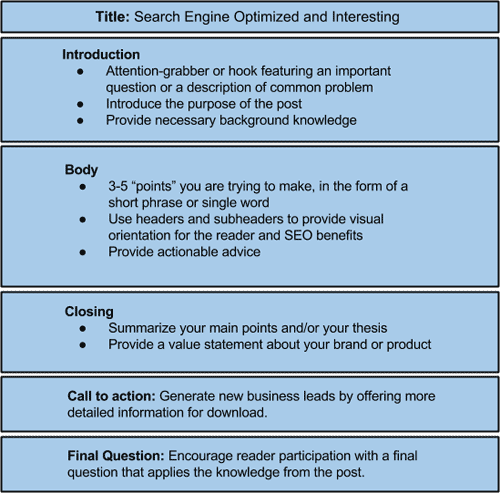 Have you ever wondered if you were writing good business blog posts, or if there was a way to make sure every post was the best it could be?
Have you ever wondered if you were writing good business blog posts, or if there was a way to make sure every post was the best it could be?
While it’s important to have a good mix of different kinds of posts, if you get stuck on how to format or organize your thoughts, here’s how to cover your bases.
Title
Your title is one of the most important parts of your business blog post because it is the piece that convinces your audience to click through and read your work.
Which do you think is more enticing to read: “SEO Tips,” or “Basic SEO Tips Google Wants Everyone to Know?”
The title “Our Case Study,” or “Business Blogging Case Study: Proof that Blogging Increases Web Traffic?”
The answer is clear -- the more descriptive and interesting you can make your blog post title to your reader, the more likely the reader will want to check out your post. But there’s another benefit to using important, interesting keywords: it increases the search engine optimization of your post, making it even more likely that it will be found in a prospective client’s search results.
Introduction
After the title, the introduction is your chance to make or break your reader’s attention. This is your opportunity to let the reader know why they need to care about this topic, and what this topic can do for them.
A good introduction will give a small amount of background information to make sure the reader is informed, then launch right into why it’s important to care and what the reader can do with this information.
Body
When it comes to making points, odd numbers are best. Your body should contain 3-5 main points that are identified using HTML headers. Not only will this optimize your text for web crawlers, but it also provides visual guidance for your reader -- an important part of maintaining a high level of readability for your prospective client.
Closing
Formal conclusions aren’t appropriate for most forms of online content -- your reader is busy, and needs you to get to the point. However, often topics need some kind of closing, final thought, or final push for the reader to grasp the entirety of your point.
The final paragraph of your post is your opportunity to drive the point home and leave your reader reflecting on what action steps they can take next.
Call to Action
You’ve attracted your prospect to your blog, so now make the most of it. Here’s your chance to turn a visitor into an information-qualified new business lead. If you have more detailed information to offer your reader, create a graphic that “calls” them to action (the “action” is a download where they supply contact information to receive more detailed information like a guide, whitepaper, etc.).
Final Question
One of the best parts of maintaining a customer blog is the open conversation available with prospective clients. Include a final thought or question to your posts to encourage your readers to get involved and to ask or answer questions. Not only will this allow your readers to engage with your company, but it also gives you the opportunity to make a personal first impression.
Do you have trouble writing good blog posts? What do you think is the most difficult part of the process?







